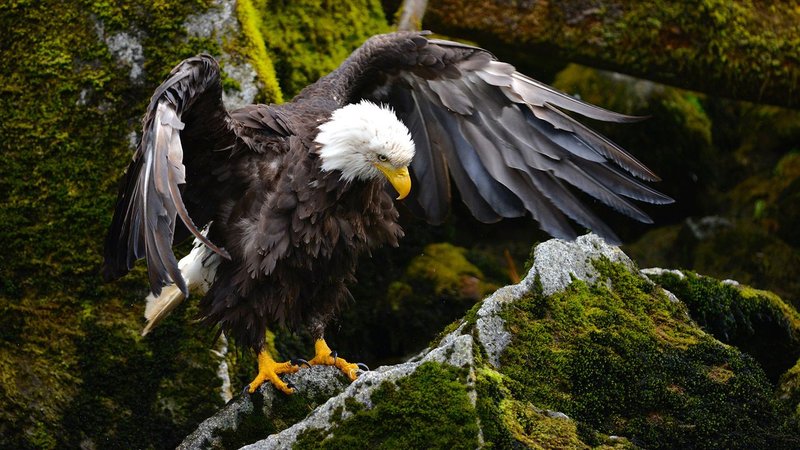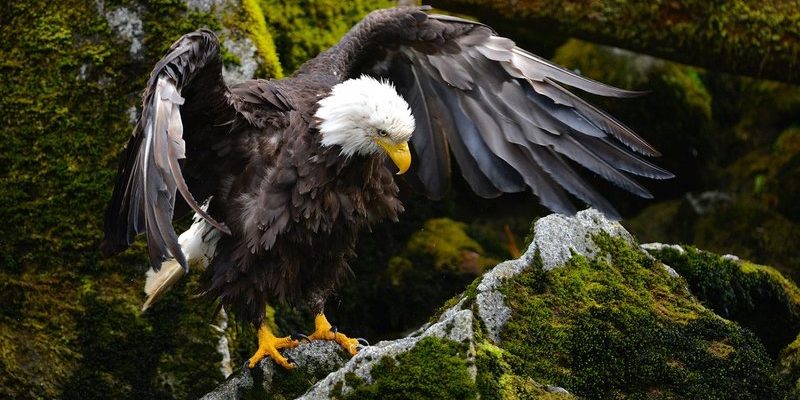
Physical Characteristics of Bald Eagles
To identify a bald eagle, you’ll first want to pay attention to its physical features. Adult bald eagles are easy to recognize thanks to their striking plumage. They have a white head and tail, contrasting sharply with their dark brown body and wings. This combination makes them one of the most visually stunning birds in North America. The stark white feathers stand out, especially against a blue sky, like snow-capped mountains on a clear day.
Another important feature is their beak. Bald eagles have a large, hooked bill that’s bright yellow. This beak is not only powerful but also designed for hunting. You might notice them tearing into their meals with that impressive beak! Young bald eagles, on the other hand, can be more challenging to identify. They don’t have the iconic white head and tail until they reach about five years of age. Instead, they display mottled brown feathers that can blend in more with their surroundings.
Finally, let’s talk about their size. Bald eagles are quite large, with a wingspan that can reach up to 7.5 feet! This makes them one of the largest birds of prey in North America. When you see one soaring, you can distinguish it from other birds by its broad, wingspan and slow, graceful flight.
Behavioral Traits to Observe
Now that you know what a bald eagle looks like, let’s explore their behavior. Observing how they act can provide crucial clues in identifying them. Bald eagles are known for their soaring flight. They often glide on thermals, which are rising columns of warm air, allowing them to travel long distances with minimal effort. If you see a large bird gliding smoothly, it might just be a bald eagle taking advantage of those thermals.
You might also notice their hunting techniques. These eagles are opportunistic feeders. While they love catching fish, they’re also known to scavenge and steal from other birds, which can be quite the show! If you see a bird diving or circling near the water, pay close attention; it might be a bald eagle preparing to make a meal out of a fish.
Additionally, bald eagles often perch in tall trees or on rocky outcrops, giving them a great vantage point to spot prey. If you see a large bird sitting high on a branch, look closely at it to see if it matches the physical characteristics we discussed earlier.
Where to Look for Bald Eagles
Finding bald eagles in the wild can sometimes feel like a treasure hunt. They prefer habitats near large bodies of open water, including lakes, rivers, and coastal regions. This is primarily because of their diet, which consists largely of fish. If you’re hoping to catch a glimpse of these majestic birds, you’ll want to explore areas where the water is abundant and there are plenty of tall trees for perching.
Consider visiting national parks or wildlife refuges, especially those known for their eagle populations. For example, Chesapeake Bay and Lake Superior are hotspots where bald eagles are frequently sighted. Early morning or late afternoon is the best time to spot them. That’s when they’re often most active, hunting for food or scouting their territory.
Don’t forget to bring some binoculars! They can help you catch a closer look at eagles that might be perched high in the trees or soaring far above. It’s like having a front-row seat to a natural performance.
Seasonal Changes and Migration Patterns
Understanding the seasonal behaviors of bald eagles can enhance your chances of spotting them. In many regions, bald eagles are migratory. During late summer and early autumn, they often move to areas with abundant food sources. This means that your chances of seeing them can vary depending on the season.
In the winter, they tend to congregate in areas where water doesn’t freeze over. This is often near rivers or lakes that haven’t completely frozen, as they rely on open water for fishing. If you’re out and about in winter, keep your eyes peeled near these spots.
During the breeding season, which usually occurs from late winter to early spring, bald eagles can often be seen near their nests. Their nests are huge—some can be as large as a small car! These nests are built high in trees and can be quite impressive to see. If you spot a nest, there’s a good chance that eagles will be nearby, especially if you’re there at the right time.
Listening for Vocalizations
Though bald eagles are mostly visual creatures, their vocalizations can also be a helpful identifying tool. They have a variety of calls, which sound more like a series of high-pitched whistling or chirping notes rather than the typical “screech” you might expect from a bird of prey. These calls are often used in communication between mates or during territorial displays.
If you hear a series of short, high-pitched sounds echoing through the trees, pay attention! It could be a bald eagle announcing its presence. The sound can be easy to miss amidst the other wildlife sounds, so keep your ears open while you’re observing the surroundings.
Using Tools to Aid Identification
If you’re serious about birdwatching, consider using tools to enhance your experience. Apps and field guides can provide valuable insights and visuals to help confirm your sightings. There are tons of excellent bird identification apps available that allow you to search for local birds using images and sounds.
You might want to use binoculars to get up-close views, but if you’re looking for a more detailed exploration, a spotting scope can be a fantastic investment. It provides a closer look at distant birds while keeping your distance.
Another great tool is notebooks or journals. Keeping a record of your observations can enhance your appreciation for bald eagles and help you notice patterns over time. You’ll be able to document where and when you see them, which can improve your identification skills for future encounters.
Final Thoughts
Identifying a bald eagle in the wild is a rewarding experience. With their majestic appearance and fascinating behavior, they’re truly a sight to behold. Remember to look for their distinct physical traits, observe their behaviors, and explore suitable habitats. Keep your ears open for their unique calls and invest in tools that can help with your identification efforts.
The next time you’re out in nature, take the time to watch the sky and the trees. With a little patience and practice, you’ll be well on your way to confidently spotting a bald eagle, turning a regular stroll into an unforgettable adventure. Happy birdwatching!

